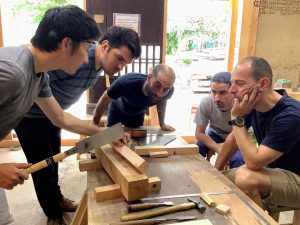Traditional Japanese joineries are functional, beautiful, yet the majority of the time it’s hidden behind the flavourless walls and ceilings. Even though they may end up being covered, framing parts are complicatedly interlaced together, much like a puzzle. This is indeed a fascinating thing.
But why do carpenters put in the effort to produce these puzzle-like joineries if they are not going to be seen?
Is it made to show off a carpenter’s skill? Were carpenters challenging the designs to see how far they could go to achieve the desired function?
When you think over it, who were the carpenters trying to impress? Their hard work would be obscured by walls and ceilings, probably never seen again within their lifetime.
The chances are these joineries were not for the simple bragging rights. Instead, I believe these were wonderful messages for the people who love this craft, who would unveil it in a 100, 500, or even in 1000 years time.
Long ago, by thoroughly studying the wood, to meet the desired functionality, using only wood and hand tools, our ancestors refined their skills, and taught us, in the form of joineries,
to enjoy the splendid woodworking.
When you think of it this way, doesn’t it make it even more exciting!
In order to deliver such a wonderful message in a 1000 years time, I look to enjoy woodworking even more!
At Suikoushya, we share traditional Japanese woodworking techniques and skills. Since it is a small group system, we will provide guidance tailored to each individual’s skills, from beginners to woodworking professionals. Please join us!
I look forward to sharing fine woodworking with you.
One month Japanese woodworking classes

